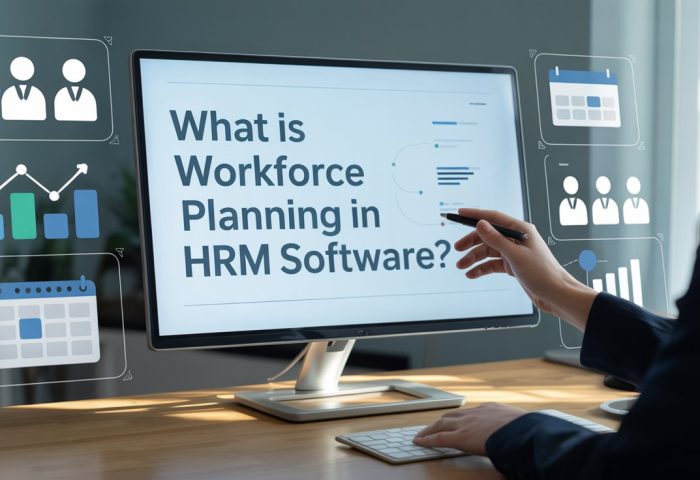In India’s fast-moving and highly competitive environment—whether it is IT services in Bengaluru, manufacturing in Gujarat, or retail in Tier-II cities—workforce planning is no longer just an HR activity. It is now a strategic necessity. Companies across industries are realizing that the ability to align people and business goals represents the pathway to sustained success.
Workforce planning enables businesses to stay ahead of growth, seasonal fluctuations, skills gaps, and organisational change. When supported by new-generation HRM software, it becomes a clever, forward-looking process—a way that Indian businesses can get the nimbleness they require in the modern marketplace.
What Is Workforce Planning?
Workforce planning is the practice of reviewing your current staff, planning for future manpower requirements, and acting to bridge the gap through hiring, training, or restructuring.
It provides answers to critical questions such as:
- Do we have the appropriate talent available for our future projects?
- Will our attrition or retirements create skill gaps?
- Will we be able to reach our growth targets with the current people?
- Will we develop our talent internally or bring someone from the outside?
Workforce planning is a short- and long-term strategy. From fulfilling peak period staffing of a logistics firm to leadership pipeline development within an IT firm, it is a model that is available for every Indian organisation, regardless of size.
Core Components of Workforce Planning
These are the normal aspects of the workforce planning process:
1. Review of the Current Workforce
Headcount, skills, designations, departments, and demographics across the firm.
2. Future Needs Forecasting
Estimating the type of workforce the business will require based on plans for growth, emerging industry trends, new projects, or expansion.
3. Identifying Shortages or Conversations
Comparing supply (existing workforce) to demand (future demand) to identify shortages or conversation.
4. Creating Solutions
Taking corrective action, whether through recruitment, promotions, transfer, retention, outsourcing or training, to realign workforce capacity and support the business strategy.
5. Reviewing and Adjusting
Regularly evaluating the plan and making changes based on either market or business performance.
In a traditional methodology, these activities are typically performed manually, through spreadsheets, and in isolation. The introduction of HRM software allows a more efficient and data-driven approach to the entire process.
Why Workforce Planning Is Important for Indian Businesses
Workforce planning is particularly necessary in India for several business realities:
Highly Volatile Workforce
Employee volatility is very high in India, and particularly prevalent among IT and startup firms. Planning allows businesses to manage attrition and retain talent in key positions.
Seasonal and Project-Based Recruiting
In industries such as construction, retail, and logistics, demand is seasonal. Workforce planning facilitates timely redeployment or hiring.
Skill Gaps and Training Needs
Upskilling the existing workforce is cheaper than mass hiring due to automation and AI roles being disrupted.
Cost Pressure
Workforce planning prevents overstaffing (which is expensive) as well as understaffing (which creates growth impediments).
Diversity and Regional Considerations
India’s diverse regions present various hiring patterns, language requirements, and talent availability. Workforce planning introduces discipline to navigating this complexity.
How HRM Software Facilitates Smarter Workforce Planning
New-generation Best HRM software is more than just payroll and attendance—it is also a key driver in enabling businesses to plan their workforce in a smart manner. Here’s how:
1. Centralised Workforce Data
All employees’ data—skills, job, experience, and performance are in a centralised repository to enable fast decision-making.
Our HR leaders can make quick and factual decisions.
2. Forecasting Tools
HRM software can provide forecasting of future manpower needs based on past hiring, turnover, and project timelines.
As an example:
A company that provides software services can forecast the need for Java developers prior to starting work on a significant client six months before onboarding.
3. Attrition and Retirement Analysis
Indian companies often have sudden exits. The HRM software can provide you with information about forthcoming resignations and retirements, so you will have time to prepare.
4. Skill Gap Analysis
This allows you to compare your current employees’ skills to your future needs, and determine whether you need to hire, train or redeploy.
5. Succession Planning
You can identify star employees for future leadership roles, which will help assure the continuity of your critical roles.
6. Automated Dashboards and Reporting
No more repetitive Excel dashboard reports, HR becomes completely transparent with reports on headcount, attrition, diversity, department needs, and so much more
Reasons Why You Should Consider DoInsights HRM
DoInsights HRM software provides Indian companies with a means to stay in control of the workforce planning process. It provides planning dashboards, skill maps, forecasting of demand, and automated reporting – in fact, we do it with the planning, starting process, and then you would be in the execution process.
Different from technology to manufacturing, healthcare, and education, the uniqueness of DoInsights will enable you to customize your HR plan to grow with your business and provide a competitive advantage. It also accommodates multi-location teams and Indian labour laws, making it a perfect fit for growing businesses.
Conclusion
Workforce planning is not a necessity anymore—it’s a must for every Indian business that wants to plan strategically and maintain performance. With unstable attrition, rapid growth, and mounting skill gaps, forward-looking organisations that plan ahead of time will remain ahead in the competition.
Manual planning just can’t match the pace of business. With HRM software, workforce planning is smarter, faster, and more closely aligned with business results. Ready to create a future-ready workforce? Schedule a free demo with DoInsights HRM and plan smarter—today and tomorrow.


